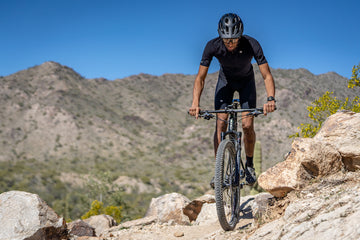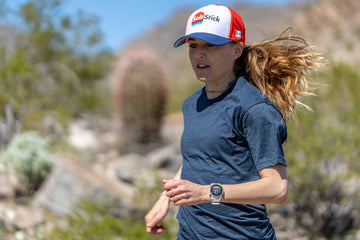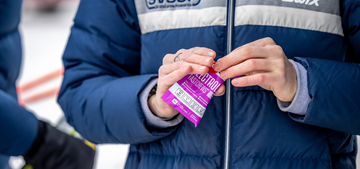
Many elite endurance athletes spend some portion of their training calendar living in high-altitude cities such as Boulder, Colorado, or Flagstaff, Arizona, to acclimate their bodies for a high-altitude event (such as the Western States 100, for example, which exceeds 8,700 feet or 2,650 meters in some places) or to improve performance when they compete back at sea level.
The concentration of oxygen in the air at high altitude is lower than at sea level, and in response, the body acquires more red blood cells to carry oxygen to the muscles. When the athlete returns to sea level, the additional oxygen available in the blood cells will give a boost to the muscles and to the athlete’s performance. This adaptation is maintained for a few days to a few weeks.
As with any physical adaptation, high-altitude training is taxing on the human body. If you plan to train or race at elevations above 5,000 feet (about 1,500 meters), you will need to take precautions and a different approach to hydration.
Hydration at higher altitudes
Air at higher altitudes is usually drier compared to sea level, which causes sweat to evaporate more quickly. In this environment, a person can be unaware of how much he or she is really sweating.
Lower oxygen levels also cause a person to breathe in and out more rapidly and deeply, to help bring in more oxygen. As a result, greater amounts of water and carbon dioxide are lost through respiration. The change in carbon dioxide loss impacts the body’s pH balance, which causes the kidneys to excrete substances via urination to help restore the balance.
In fact, one 2015 study examined 28 people on a multi-day trek in Nepal who ascended to altitudes of 11,200 feet (3,440 meters) on the 3rd day and 16,500 feet (5,050 meters) on the 14th day. Data showed that the mean 24-hour urine production increased significantly in both men and women across the expedition, compared to baseline measurements at sea level.
In other words, at high altitude, you will pee more!
Collectively, these effects will increase a person’s hydration needs, and some estimates advise athletes to drink an extra 1 to 1.5 liters of water daily.
The importance of electrolytes
Electrolytes play a crucial role in hydration. When we sweat, we lose electrolytes, including sodium, potassium, calcium, and magnesium. The Wilderness Medicine Society warns that if high-altitude athletes do not take precautions to replace lost electrolytes and rely only on water to stay hydrated, they run the risk of developing hyponatremia. This dangerous condition, caused by low levels of sodium in the blood, can lead to lower performance, as well as headaches, nausea, disorientation, and fatigue. Therefore, as water consumption is increased to meet the demands of higher-altitude training, electrolyte consumption should also be increased.
SaltStick DrinkMix can be a great aid for consuming electrolytes at high altitudes. As a delicious, no-sugar, ready-to-mix powder, DrinkMix provides a similar ratio of electrolytes to what your body loses through sweat. Just mix one packet into 16-20 oz. of water to your preferred concentration and consume every 60-90 minutes during physical activity, for up to five servings daily.
Additionally, the following chart may help when planning your hydration routine. Please remember each athlete is different, and you should therefore adapt this to fit your unique needs.
| Elevation | Additional Water | Additional Electrolytes (Beyond Normal Recommendations) |
| Sea Level - 5,000 feet (1500 meters) | None | None; adhere to normal recommendations |
| Altitude: 5,000 - 8,000 feet (1,500 meters - 2,400 meters) | 0.5 liters | 250 mg of sodium (approx. 1 SaltStick Capsule, 4 FastChews, or ½ serving DrinkMix*) per hour, during exercise |
| High altitude: 8,000 - 12,000 feet (2,400 - 3,650 meters) | 1 to 1.5 liters | 250 mg of sodium (approx. 1 SaltStick Capsule, 4 FastChews, or ½ serving DrinkMix*), during exercise |
| Very high altitude: 12,000 - 18,000 feet (3,650 - 5,500 meters) | 2 to 2.5 liters | 500 mg of sodium (approx. 2 SaltStick Capsules, 8 FastChews, or 1 serving DrinkMix*) per hour, during exercise |
| Extremely high altitude: 18,000+ feet (5,500+ meters) | In extreme situations, it’s best to work with an expert to determine your unique needs. | |
Adapting to high altitudes
As mentioned previously, when we ascend into higher altitudes, the amount of oxygen in the air decreases, and we take in lower amounts of oxygen with each breath. (Notably, oxygen remains 21% of the air by volume even at a higher altitude, but each breath takes in fewer molecules of all the gases that comprise air).
Oxygen is crucial for our cells to function; without it, the human brain will die after just six minutes. At elevations beyond 5,000 feet (1,500 meters) the body’s ability to utilize oxygen and deliver it to the tissues decreases by 3% for every 1,000 feet (300 meters). This lack of oxygen also results in characteristic altitude sickness symptoms: headache, nausea, shortness of breath and “bonking,” or the inability to push yourself physically.
Most people can adapt to the lower oxygen levels after a few days, but it is important to give the body time to make the necessary physical changes at high altitudes before performing an intense workout. The Institute for Altitude Medicine recommends that athletes performing aerobic events at elevations over 5,000 feet have 10-20 days of acclimatization.
Moreover, athletes participating in events over 12,000 feet must first go through acclimatization at an intermediate altitude prior to performance to avoid altitude sickness.
During these acclimatization phases, the athlete can experiment with changes to his or her hydration routine. Proper hydration and electrolyte intake, low alcohol consumption and slow ascent can help reduce the likelihood of altitude sickness. If an athlete does suffer from altitude sickness, there is no cure except for transitioning to a lower altitude to slow the adaptation process down.
Conclusion
If you are headed to a high-altitude location to train or race, be sure to pay attention to the unique hydration needs you will face. With proper planning, you will be ready to perform safely and at your best.
Disclaimer: Contact your physician before starting any exercise program or if you are taking any medication. Individuals with high blood pressure should also consult their physician prior to taking an electrolyte supplement. Overdose of electrolytes is possible, with symptoms such as vomiting and feeling ill, and care should be taken not to overdose on any electrolyte supplement.








